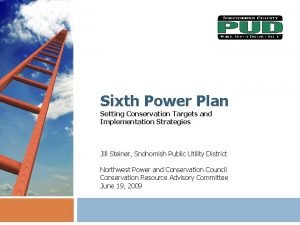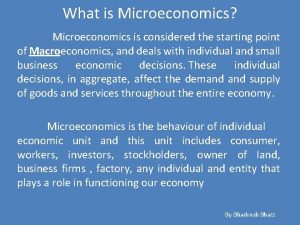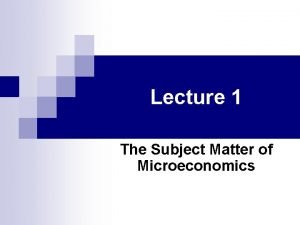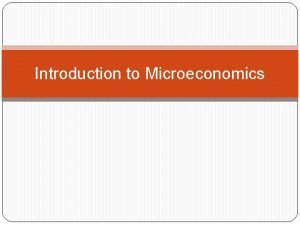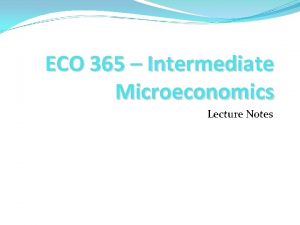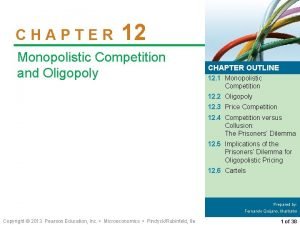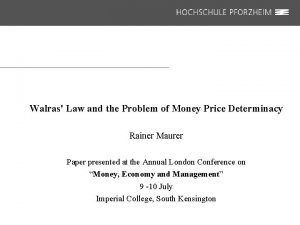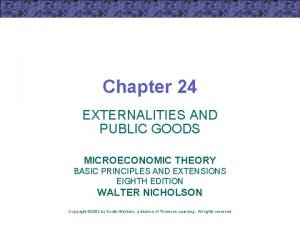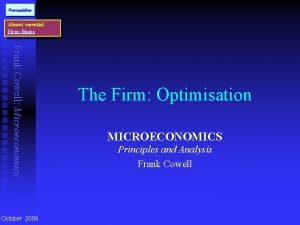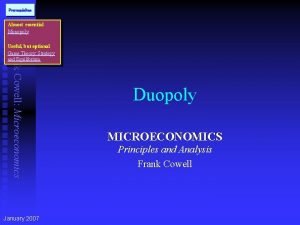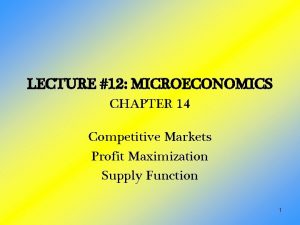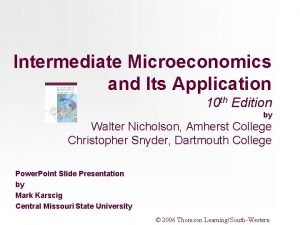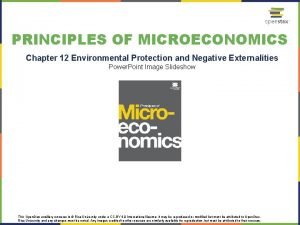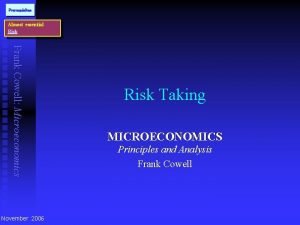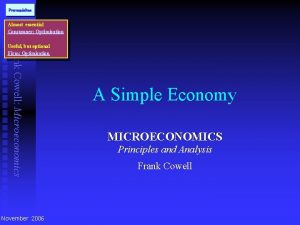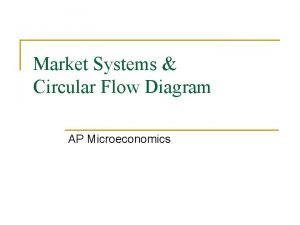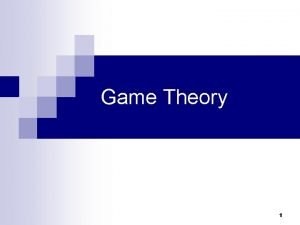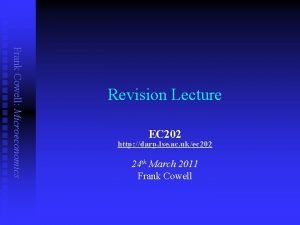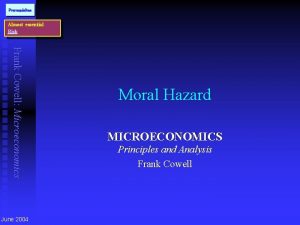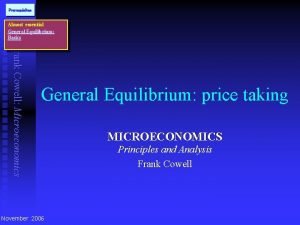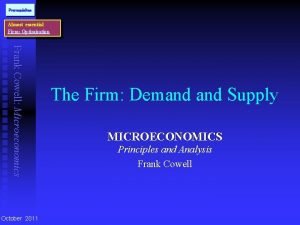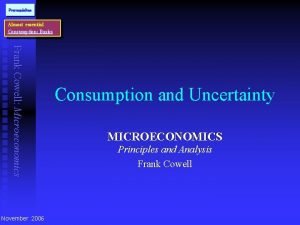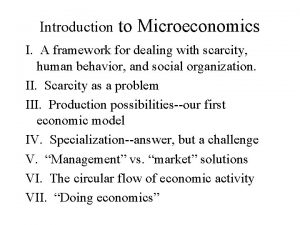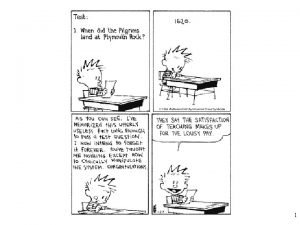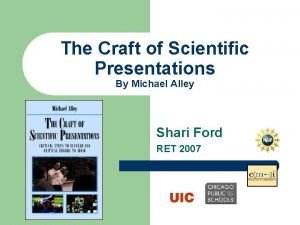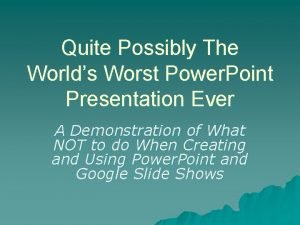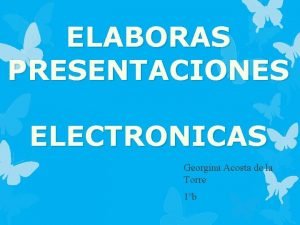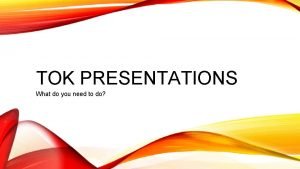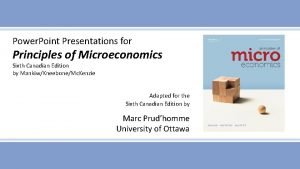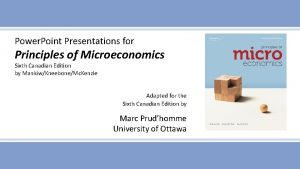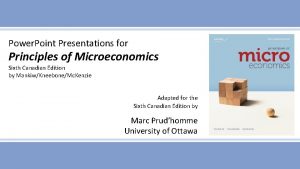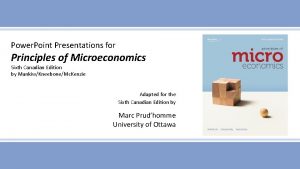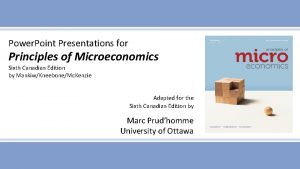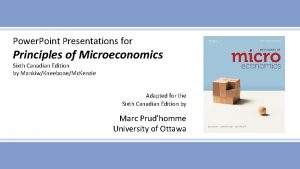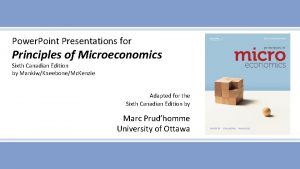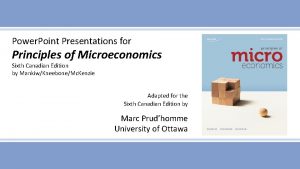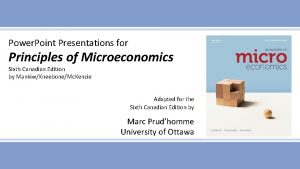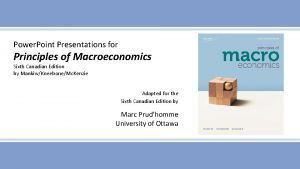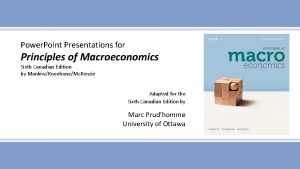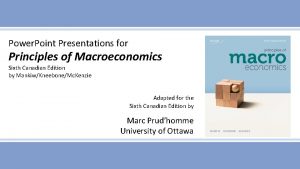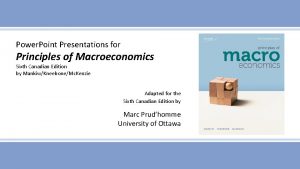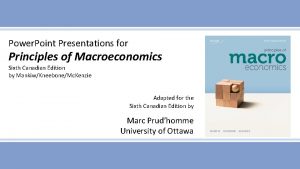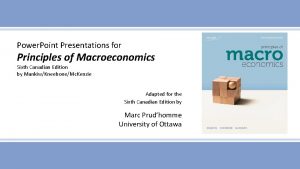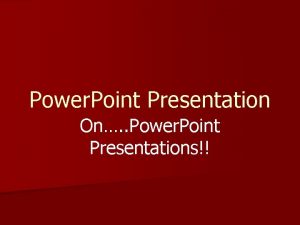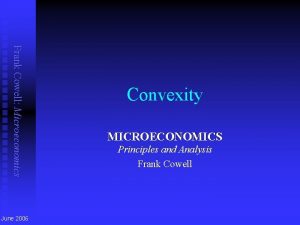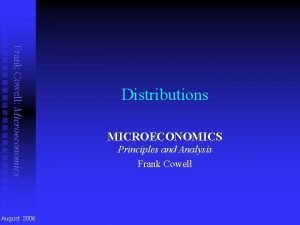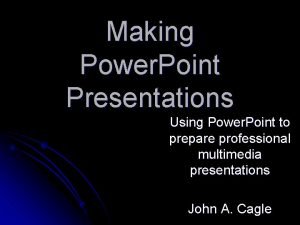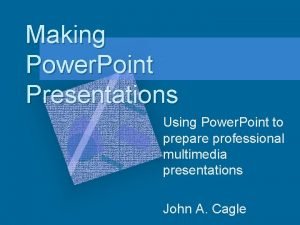Power Point Presentations for Principles of Microeconomics Sixth














































- Slides: 46

Power. Point Presentations for Principles of Microeconomics Sixth Canadian Edition by Mankiw/Kneebone/Mc. Kenzie Adapted for the Sixth Canadian Edition by Marc Prud’homme University of Ottawa

THE COSTS OF PRODUCTION Chapter 13 Copyright © 2014 by Nelson Education Ltd. 13 -2

THE COSTS OF PRODUCTION § In this chapter and the ones that follow, we examine firm behaviour in more detail. § This topic will give you a better understanding of what decisions lie behind the supply curve in a market. § In addition, it will introduce you to a part of economics called industrial organization: the study of how firms’ decisions regarding prices and quantities depend on the market conditions they face. Copyright © 2014 by Nelson Education Ltd. 13 -3

THE COSTS OF PRODUCTION § The town in which you live, for instance, may have several pizzerias but only one cable television company. § How does this difference in the number of firms affect the prices in these markets and the efficiency of the market outcomes? § The field of industrial organization addresses exactly this question. Copyright © 2014 by Nelson Education Ltd. 13 -4

WHAT ARE COSTS? § We begin our discussion of costs at Hungry Helen’s Cookie Factory. § Helen, the owner of the firm, buys flour, sugar, chocolate chips, and other cookie ingredients. § She also buys the mixers and ovens and hires workers to run this equipment. § She then sells the resulting cookies to consumers. Copyright © 2014 by Nelson Education Ltd. 13 -5

Total Revenue, Total Cost, and Profit § Total revenue (for a firm): the amount a firm receives for the sale of its output § Total cost: the market value of the inputs a firm uses in production § Profit: total revenue minus total cost Copyright © 2014 by Nelson Education Ltd. 13 -6

Costs as Opportunity Costs § The cost of something is what you give up to get it. Recall that the opportunity cost of an item refers to all those things that must be forgone to acquire that item. § When economists speak of a firm’s cost of production, they include all the opportunity costs of making its output of goods and services. Copyright © 2014 by Nelson Education Ltd. 13 -7

Costs as Opportunity Costs § Explicit costs: input costs that require an outlay of money by the firm § Implicit costs: input costs that do not require an outlay of money by the firm Copyright © 2014 by Nelson Education Ltd. 13 -8

The Cost of Capital as an Opportunity Cost § An important implicit cost of almost every business is the opportunity cost of the financial capital that has been invested in the business. § Helen used $300 000 of her savings to buy her factory. § If Helen had instead left this money in a savings account that pays an interest rate of 5 percent, she would have earned $15 000 per year. § This forgone $15 000 is one of the implicit opportunity costs of Helen’s business. Copyright © 2014 by Nelson Education Ltd. 13 -9

Economic Profit versus Accounting Profit § Because economists and accountants measure costs differently, they also measure profit differently. § An economist measures a firm’s economic profit as the firm’s total revenue minus all the opportunity costs (explicit and implicit) of producing the goods and services sold. § An accountant measures the firm’s accounting profit as the firm’s total revenue minus only the firm’s explicit costs. Copyright © 2014 by Nelson Education Ltd. Thinkstock 13 -10

FIGURE 13. 1: Economists versus Accountants Copyright © 2014 by Nelson Education Ltd. 13 -11

Quick. Quiz Farmer Mc. Donald gives banjo lessons for $20 an hour. One day he spends 10 hours planting $100 worth of seeds on his farm. What opportunity cost has he incurred? What cost would his accountant measure? If these seeds will yield $200 worth of crops, does Mc. Donald earn an accounting profit? Does he earn an economic profit? Copyright © 2014 by Nelson Education Ltd. 13 -12

PRODUCTION AND COSTS § In the analysis that follows, we make an important simplifying assumption: We assume that the size of Helen’s factory is fixed and that Helen can vary the quantity of cookies produced only by changing the number of workers. § This assumption is realistic in the short run but not in the long run. Copyright © 2014 by Nelson Education Ltd. 13 -13

§ Production function: the relationship between the quantity of inputs used to make a good and the quantity of output of that good Everett Collection/Shutterstock The Production Function Copyright © 2014 by Nelson Education Ltd. 13 -14

TABLE 13. 1: A Production Function and Total Cost: Hungry Helen’s Cookie Factory Copyright © 2014 by Nelson Education Ltd. 13 -15

FIGURE 13. 2: Hungry Helen’s Cookie Factory Production Function Total-Cost Curve Copyright © 2014 by Nelson Education Ltd. 13 -16

The Production Function § Marginal product: the increase in output that arises from an additional unit of input § Diminishing marginal product: the property whereby the marginal product of an input declines as the quantity of the input increases Copyright © 2014 by Nelson Education Ltd. 13 -17

From the Production Function to the Total-Cost Curve § The last three columns of Table 13. 1 show Helen’s cost of producing cookies. § The cost of Helen’s factory is $30 per hour, and the cost of a worker is $10 per hour. § If she hires one worker, her total cost is $40. § If she hires two workers, her total cost is $50, and so on. § With this information, the table now shows how the number of workers Helen hires is related to the quantity of cookies she produces and to her total cost of production. Copyright © 2014 by Nelson Education Ltd. 13 -18

Quick. Quiz If Farmer Jones plants no seeds on his farm, he gets no harvest. If he plants one bag of seeds, he gets three bushels of wheat. If he plants two bags, he gets five bushels. If he plants three bags, he gets six bushels. A bag of seeds costs $100, and seeds are his only cost. Use these data to graph the farmer’s production function and total-cost curve. Explain their shapes. Copyright © 2014 by Nelson Education Ltd. 13 -19

THE VARIOUS MEASURES OF COST § From data on a firm’s total cost, we can derive several related measures of cost, which will turn out to be useful when we analyze production and pricing decisions in future chapters. Copyright © 2014 by Nelson Education Ltd. 13 -20

TABLE 13. 2: The Various Measures of Cost: Thirsty Thelma’s Lemonade Stand Copyright © 2014 by Nelson Education Ltd. 13 -21

Fixed and Variable Costs § Fixed costs: costs that do not vary with the quantity of output produced § Variable costs: costs that do vary with the quantity of output produced. Copyright © 2014 by Nelson Education Ltd. 13 -22

FIGURE 13. 3: Thirsty Thelma’s Total-Cost Curve Copyright © 2014 by Nelson Education Ltd. 13 -23

Fixed and Variable Costs § Fixed costs: costs that do not vary with the quantity of output produced § Variable costs: costs that do vary with the quantity of output produced § A firm’s total cost is the sum of fixed and variable costs. Copyright © 2014 by Nelson Education Ltd. 13 -24

Average and Marginal Costs § As the owner of her firm, Thelma has to decide how much to produce. § Thelma might ask her production supervisor the following two questions about the cost of producing lemonade: 1. How much does it cost to make the typical glass of lemonade? 2. How much does it cost to increase production of lemonade by one glass? Copyright © 2014 by Nelson Education Ltd. 13 -25

Average and Marginal Costs § Average total cost (ATC): total cost divided by the quantity of output § Average fixed cost (AFC): fixed costs divided by the quantity of output § Average variable cost (AVC): variable costs divided by the quantity of output § Marginal cost (MC): the increase in total cost that arises from an extra unit of production Copyright © 2014 by Nelson Education Ltd. 13 -26

Average and Marginal Costs Copyright © 2014 by Nelson Education Ltd. 13 -27

Active Learning Calculating Costs Fill in the blank spaces of this table. Q VC 0 1 10 2 30 TC AFC AVC ATC $50 n/a n/a $10 $60. 00 80 3 16. 67 4 100 5 150 6 210 150 20 12. 50 36. 67 8. 33 $10 30 37. 50 30 260 MC 35 Copyright © 2014 by Nelson Education Ltd. 43. 33 60 13 -28

Active Learning Answers First, deduce FC between = $50 and use FCTC + VC = TC. Use relationship MC and AFC == FC/Q VC/Q Use AVC ATC TC/Q Q VC TC AFC AVC ATC 0 $0 $50 n/a n/a 1 10 60 $50. 00 $10 $60. 00 2 30 80 25. 00 15 40. 00 3 60 110 16. 67 20 36. 67 4 100 150 12. 50 25 37. 50 5 150 200 10. 00 30 40. 00 6 210 260 8. 33 35 43. 33 Copyright © 2014 by Nelson Education Ltd. MC $10 20 30 40 50 60 13 -29

Cost Curves and Their Shapes §Graphs of average and marginal cost are useful when analyzing the behaviour of firms. Copyright © 2014 by Nelson Education Ltd. 13 -30

FIGURE 13. 4: Thirsty Thelma’s Average-Cost and Marginal-Cost Curves Copyright © 2014 by Nelson Education Ltd. 13 -31

Cost Curves and Their Shapes Rising Marginal Cost § Thirsty Thelma’s marginal cost rises with the quantity of output produced. § This reflects the property of diminishing marginal product. Copyright © 2014 by Nelson Education Ltd. 13 -32

Cost Curves and Their Shapes U-Shaped Average Total Cost §To understand why this is so, remember that average total cost is the sum of average fixed cost and average variable cost. § Average fixed cost always declines as output rises because the fixed cost is spread over a larger number of units. § Average variable cost typically rises as output increases because of diminishing marginal product. Copyright © 2014 by Nelson Education Ltd. 13 -33

Cost Curves and Their Shapes Efficient scale: the quantity of output that minimizes average total cost Copyright © 2014 by Nelson Education Ltd. 13 -34

Cost Curves and Their Shapes The Relationship between Marginal Cost and Average Total Cost § Whenever marginal cost is less than average total cost, average total cost is falling. § Whenever marginal cost is greater than average total cost, average total cost is rising. Copyright © 2014 by Nelson Education Ltd. 13 -35

FIGURE 13. 5: Cost Curves for a Typical Firm Copyright © 2014 by Nelson Education Ltd. 13 -36

Typical Cost Curves § The cost curves shown here share three properties that are most important to remember: 1. Marginal cost eventually rises with the quantity of output. 2. The average-total-cost curve is U-shaped. 3. The marginal-cost curve crosses the average-total-cost curve at the minimum of average total cost. Copyright © 2014 by Nelson Education Ltd. 13 -37

Quick. Quiz Suppose Honda’s total cost of producing four cars is $225 000 and its total cost of producing five cars is $250 000. What is the average total cost of producing five cars? What is the marginal cost of the fifth car? Draw the marginal-cost curve and the average-totalcost curve for a typical firm, and explain why these curves cross where they do. Copyright © 2014 by Nelson Education Ltd. 13 -38

COSTS IN THE SHORT RUN AND IN THE LONG RUN § We noted earlier in this chapter that a firm’s costs might depend on the time horizon being examined. Copyright © 2014 by Nelson Education Ltd. 13 -39

FIGURE 13. 6: Average Total Cost in the Short and Long Runs Copyright © 2014 by Nelson Education Ltd. 13 -40

The Relationship between Short-Run and Long-Run Average Total Cost § For many firms, the division of total costs between fixed and variable costs depends on the time horizon. § Because many decisions are fixed in the short run but variable in the long run, a firm’s long-run cost curves differ from its short-run cost curves. Copyright © 2014 by Nelson Education Ltd. 13 -41

Economies and Diseconomies of Scale § Economies of scale: the property whereby long-run average total cost falls as the quantity of output increases § Diseconomies of scale: the property whereby long-run average total cost rises as the quantity of output increases § Constant returns to scale: the property whereby long-run average total cost stays the same as the quantity of output changes Copyright © 2014 by Nelson Education Ltd. 13 -42

Quick. Quiz If Bombardier produces nine jets per month, its long-run total cost is $9. 0 million per month. If it produces ten jets per month, its long-run total cost is $9. 5 million per month. Does Bombardier exhibit economies or diseconomies of scale? Copyright © 2014 by Nelson Education Ltd. 13 -43

TABLE 13. 3: The Many Types of Cost: A Summary Copyright © 2014 by Nelson Education Ltd. 13 -44

Classroom Activity Intensive Production • I am interested in growing wheat on a very small plot of land, a plot the size of an average dorm room. • The amount of land is fixed, but any other factors can be added to increase production. • The current method of production involves throwing seeds on the land returning months later to harvest the grain. • List techniques and inputs that could be used to maximize production from this plot. Copyright © 2014 by Nelson Education Ltd. 13 -45

THE END Chapter 13 Copyright © 2014 by Nelson Education Ltd. 13 -46
 Peter piper tongue twister
Peter piper tongue twister The sixth sick sheik's sixth sheep's sick lyrics
The sixth sick sheik's sixth sheep's sick lyrics Rent principles of microeconomics
Rent principles of microeconomics Rational people think at the margin
Rational people think at the margin 100 to the sixth power
100 to the sixth power Draw the power triangle
Draw the power triangle Informsu
Informsu Point point power
Point point power What is microeconomics
What is microeconomics Micro economics examples
Micro economics examples What is the subject matter of microeconomics
What is the subject matter of microeconomics Limitations of macroeconomics
Limitations of macroeconomics Intermediate microeconomics lecture notes
Intermediate microeconomics lecture notes Intermediate microeconomics notes
Intermediate microeconomics notes Oligopoly model
Oligopoly model Walras law
Walras law Pure public good
Pure public good Cowell microeconomics
Cowell microeconomics Microeconomics michael parkin 13th edition
Microeconomics michael parkin 13th edition Definition of macroeconomics
Definition of macroeconomics Objective of microeconomics
Objective of microeconomics Microeconomics
Microeconomics Microeconomics
Microeconomics Uses of microeconomics
Uses of microeconomics System of national accounting
System of national accounting Microeconomics chapter 12
Microeconomics chapter 12 Cowell microeconomics
Cowell microeconomics Frank cowell
Frank cowell Microeconomics examples
Microeconomics examples Circular flow diagram menggambarkan
Circular flow diagram menggambarkan Nash equilibrium example
Nash equilibrium example Cowell microeconomics
Cowell microeconomics Cowell microeconomics
Cowell microeconomics Almost essential
Almost essential Frank cowell
Frank cowell Cowell microeconomics
Cowell microeconomics Microeconomics ia
Microeconomics ia Unit 1 basic economic concepts
Unit 1 basic economic concepts The craft of scientific presentations
The craft of scientific presentations Titles for mental health presentation
Titles for mental health presentation Worst us presentation ever
Worst us presentation ever Advantages of multimedia presentation
Advantages of multimedia presentation Lecture presentations for campbell biology
Lecture presentations for campbell biology Areas donde mas se utilizan las presentaciones electronicas
Areas donde mas se utilizan las presentaciones electronicas -is not one of the purposes for giving oral presentations.
-is not one of the purposes for giving oral presentations. What are the three major types of verbal support
What are the three major types of verbal support How to make a tok presentation
How to make a tok presentation




